THE LORD OF THE RINGS: THE TWO TOWERS (2002)
While Frodo and Sam edge closer to Mordor with the help of the shifty Gollum, the divided fellowship makes a stand against Sauron's new ally, Saruman, and his hordes of Isengard.
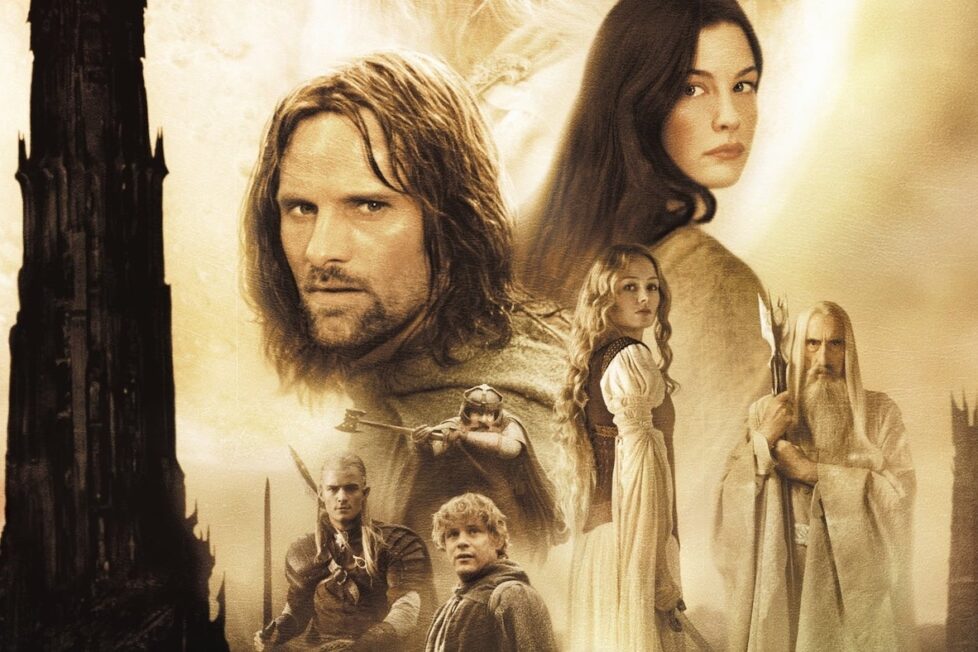
While Frodo and Sam edge closer to Mordor with the help of the shifty Gollum, the divided fellowship makes a stand against Sauron's new ally, Saruman, and his hordes of Isengard.


It’s one thing to capture lightning in a bottle… it’s another entirely to keep it contained. The immediate, explosively positive response to The Lord of the Rings: The Fellowship of the Ring (2001)—still one of the most defining blockbusters ever made, and unmatched by any piece of high-fantasy filmmaking it inspired—inevitably left both new and longtime fans of Middle-earth wondering where the trilogy would go from here in the years to come, and if it would keep up the same degree of astounding quality Fellowship did in continuing J.R.R Tolkien’s literary epic. Perhaps to the benefit of consistency, director Peter Jackson’s cast and crew filmed a trilogy back-to-back, over the course of more than a year, but such an ambitiousness made the release of Fellowship an enormous liability for the next two’s release. And even after it succeeded, the first sequel would have to live up to expectations established by Fellowship to ensure the third and final instalment’s success.
With the release of The Two Towers a year later in 2002—a film deservingly hailed as the best of the trilogy by many, and by some spellbinding miracle, a near-equal in quality to Fellowship—the Lord of the Rings trilogy steadily and confidently marched onwards, harnessing the lightning captured by its predecessor to achieve countless more miracles for epic fantasy cinema. An overpoweringly ambitious, titanic expansion of the saga’s world-building, The Two Towers’ thematic expansion of its war between Good and Evil now delved deeper into new nations, races, and environments that both widened the audience’s view of the vast diversity of Middle-earth, and threw complications into the ruinous war ravaging its lands.
By the time The Fellowship of the Ring ended, its titular band of heroes—Frodo (Elijah Wood), Sam (Sean Astin), Pippin (Dominic Monaghan), Merry (Billy Boyd), Aragorn (Viggo Mortensen), Legolas (Orlando Bloom), Gimli (John Rhys-Davies), and Gandalf (Ian McKellen)—have shattered into disarray. Gandalf has been dragged by the demonic Balrog christened “Durin’s Bane” into the chasmic depths of the Mines of Moria. Uruk-hai Orcs summoned and commanded by the corrupted White Wizard, Saruman (Christopher Lee), have taken Pippin and Merry as prisoners. Frodo, fearful that the power of the One Ring will corrupt what’s left of the Fellowship, has ventured off into Mordor alone, only for his loyal friend Sam to follow him as well. It’s not until the trilogy’s climax with The Return of the King (2003)that these threads will all reunite, but The Two Towers gives each of them far more than their fair share in the narrative as it traces the scattered Fellowship’s encounters with the various nations and peoples involved in the ongoing war against the Dark Lord Sauron.
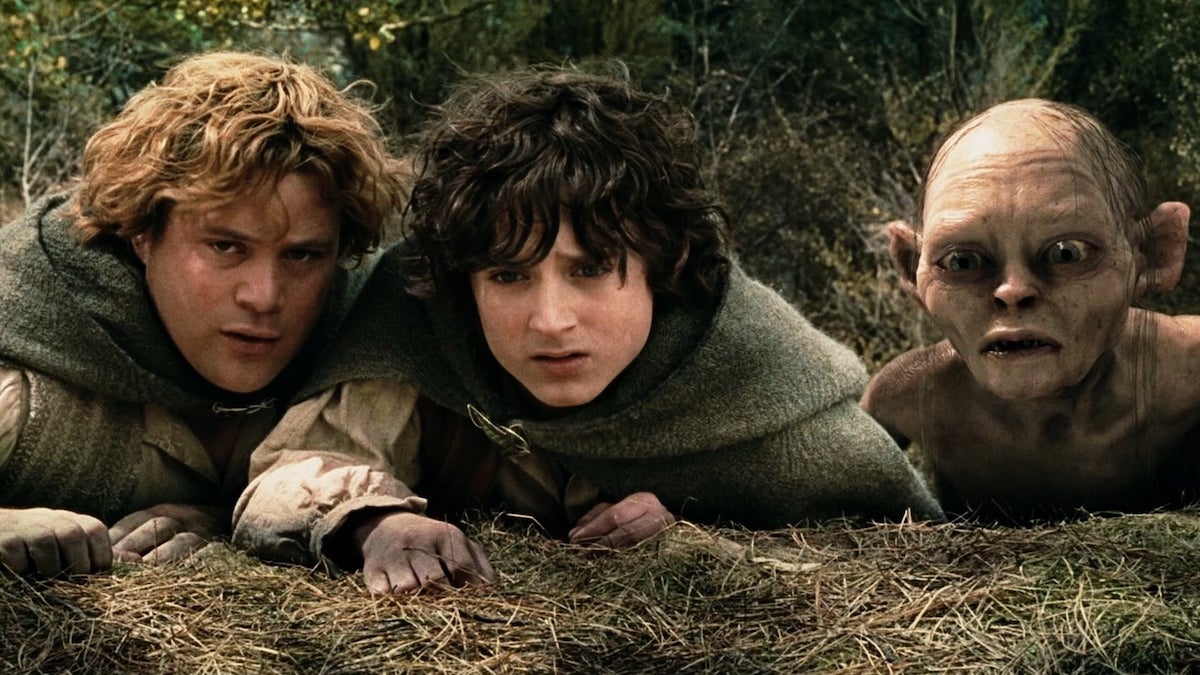
Aragorn, Legolas, and Gimli spend their first few scenes in the film trying to rescue Merry and Pippin, who’ve been taken into Fangorn Forest near the kingdom of Rohan, a nation that, as they find out later, has been weakened by Saruman’s control over their King Théoden (Bernard Hill). Although they fail to find the two hobbits in Fangorn—their Uruk-hai captors also slaughtered by Rohan’s soldiers—they eventually run into Gandalf the White, miraculously resurrected by divine forces from his battle with the Balrog in order to complete his mission to help save Middle-earth. Together, they release Théoden from Saruman’s influence, steadily restoring Rohan to its former glory, and preparing its people for the cataclysmic conflict that lies ahead as Sauron’s forces encroach their lands.
As for Merry and Pippin, their escape from the Uruk-hai leads them deep into the centre of Fangorn Forest, where they run into the Ents—a species of tree-like giants who live as protectors of the forest, and who now harbour a deep hatred for Saruman for his ravaging of the woods for his industrialization of Isengard. Overseen by the spire-like tower Orthanc (one of the titular two towers), Isengard has become a fiery rendition of hell that delves deep underground, littered with machinery, Orcs, and the mutilated remains of Fangorn being used as fuel for Saruman’s incendiary war effort, and the two hobbits try to persuade the Ents, especially their leader, Treebeard (also voices by Rhys-Davies), to take action and retaliate against Saruman’s tampering with nature.
Frodo and Sam, meanwhile, have been closely followed by Gollum (Andy Serkis), a hobbit so thoroughly corrupted from bearing the One Ring for centuries that his life has been unnaturally extended, and whose mind has become irrationally dead-set on reclaiming the Ring (affectionately and iconically referred to as his “precious”) for himself after losing it to Bilbo Baggins (Ian Holm), Frodo’s uncle, decades earlier. While Sam immediately objects to Gollum’s presence near Frodo and the Ring, Frodo, in a gesture that betrays both pity and perhaps desperation, allows Gollum to guide both of them to Mordor in order to destroy the Ring, leading all three of them down the many corners of the brutalizing path to the most unnatural land in all of Middle Earth. Their treacherous journey is littered with dangers: the Easterling armies of Men under Sauron’s control, the corpse-filled waters of the Dead Marshes, and above all else, the One Ring itself, which threatens to corrupt Frodo and Gollum once again, all while being warily eyed by the armies of Gondor, led by the late Boromir’s (Sean Bean) brother, Faramir (David Wenham), who encounter the three hobbits along the way.
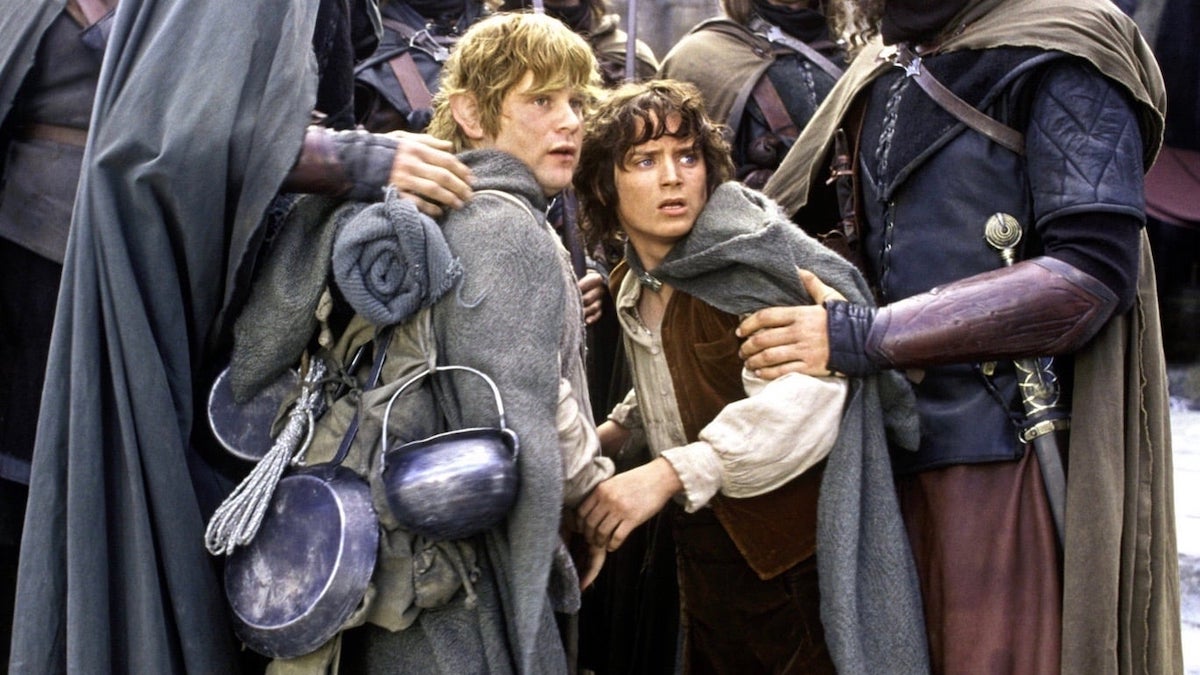
Given the title of this instalment directly refers to both Isengard’s Orthanc as well as Barad-dûr, the menacing skyscraper in the centre of Mordor housing the fiery, all-seeing Eye of Sauron himself, it comes as no surprise that The Two Towers is the film most concerned with the damage and nature of the evil slowly overtaking Middle-earth. Aragorn, Legolas, Gimli, and Gandalf, in the process of helping Rohan fend off the forces of Mordor, are given front row seats to the desperation that war and its promises of destruction bring. Rohan is deeply unprepared to fight the onslaught of Uruk-hai and Orcs headed their way, their men untrained and their numbers low, and their plans to retreat to the fortress of Helm’s Deep—an old stronghold with a fatal vulnerability that puts what is left of Rohan at risk of annihilation—is a measure that only serves to delay an inevitable, scorched-earth massacre against their people. It also doesn’t help that an entire troop of Rohirrim, led by Éomer (Karl Urban), were also exiled by a corrupted Théoden and Saruman’s servant, Grima Wormtongue (Brad Dourif)—to say that Rohan is “ready to fall,” as Saruman triumphantly gloats, is indeed no understatement. Merry and Pippin, meanwhile, see another side of this encroaching darkness through Isengard’s violation of nature, whose power they become determined to try and marshal via the Ents against Saruman’s industrial destruction.
A major triumph of The Lord of the Rings as a trilogy—a triumph none of its successors in the high-fantasy world, not even the Amazon prequel series The Rings of Power (2022), have been able to replicate—is its utterly spectacular usage of practical effects, and in turn, how it amplifies character design, especially to introduce the more militant aspects of the trilogy’s story as it orients itself further around the war’s factions. The Uruk-hai and Orcs are given perfectly fitting appearances for the conniving, malicious footsoldiers of Isengard and Mordor’s forces, with haphazardly strung-together yet intimidatingly sharp pieces of armour and weaponry that are evidently the result of Isengard’s hasty industrialization. Treebeard and the Ents, all of whom are combinations of animatronics and CGI models, move around with a slow, heavy rigidness creaky enough to convince any viewer that a moving tree-giant would take to such a stiff, sluggish, and quite literally wooden gait. The armour and attire worn by the men of Rohan and Gondor inform us of their kingdoms’ individual natures—the latter being more formally focused on plated armour universally ornamented with the White Tree of Gondor, while the former takes on a combination of chain mail and scale armour grounded in the style of medieval protection, decorated primarily with shades of green and red.
Given The Two Towers‘ emphasis on revealing further corners of Middle-earth, the production design also only serves to amplify the immersion of atmosphere and give the locations a sense of character that was so perfectly established by Fellowship. Rohan, perhaps the most grounded and rural among the kingdoms of Men introduced in the trilogy, is full of buildings constructed of wood, with spiralling patterns engraved into the arboreal walls and pillars in its construction that give it a sense of timelessness, harkening back to a nostalgically Arthurian era of kings and knights. As for the darker corners of Middle-earth, the wastelands of Isengard and Mordor are virtually monochrome outside of the bright crimson flame and lava spewing from their underground industrial tunnels and the fiery, rocky ground that the colossal armies of evil are made to stand on—the first complete glimpse we see of the aesthetics of darkness in Jackson’s rendition of Tolkien’s world, and one that works to overpowering and terrifying effect as one realizes the scope of the incomprehensible horrors of what Middle-earth might become under Sauron’s reign.
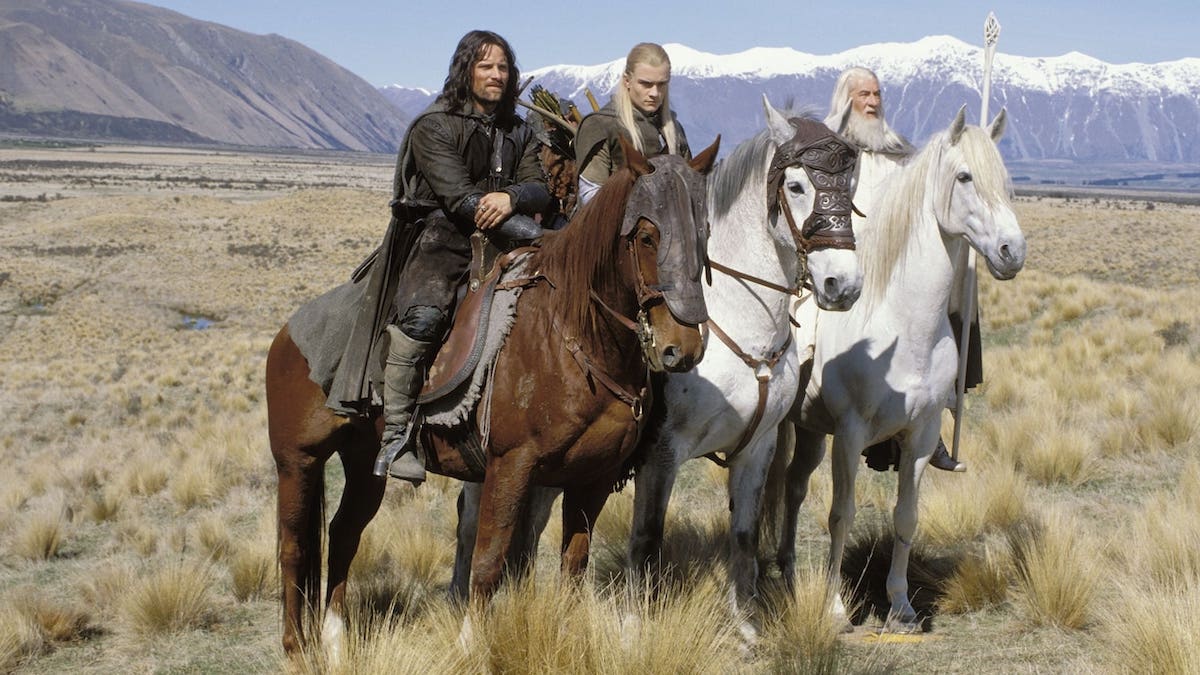
Howard Shore’s operatic score expands his beautiful library of over 100 leitmotifs in The Two Towers as well, further cementing its status as an indisputably legendary film soundtrack. In addition to the scattered theme of the Fellowship—played at its strongest with only a collection of horns, but never with a full orchestra like the Fellowship’s first complete union—the addition of Rohan into the scope of the story brings with it one of the most beautiful themes of the entire trilogy, an eight-note theme played at its most modestly melancholy by strings, and at its most stirringly moving by a collection of horns. The moment in which Théoden draws his sword once again after being freed by Gandalf from Saruman’s grasp is punctuated by a deeply inspiring, brass-driven rendition of Rohan’s theme befit for a king’s return, the announcement of his restoration to former glory that’s bound to revive confidence in any who would gaze upon such a sight.
But as the darkness grows to insurmountable heights in Middle-earth as well, Shore—in keeping with the towering menace he gave to the Nâzgul’s theme in Fellowship—offers the forces of Isengard a march heavy in percussion and overpowered by blaring low brass, a theme of pure intimidation that perfectly matches the tens of thousands of Men, Uruk-hai, and Orcs Saruman has marshalled for his trail of destruction, and audibly convinces the audience of the insurmountable scale and seemingly indestructible strength in numbers wielded by the armies of darkness incarnate. And of course, the minor-key string melody marking every mention and whispering of the One Ring returns with a greater layer of dread underlying its every appearance, as its allure and temptations grow stronger with Frodo and Sam’s journey closer to Mordor and Sauron, and as Gollum falls right back into its all-consuming darkness as he tries to take it back for himself.
As each of these characters reacts to the intensifying darkness surrounding them, every single one of the actors in this remarkable ensemble cast evolves alongside them as new conflicts introduce fresher dimensions to their characters. Boyd and Monaghan bring their trademark wit and charm to Merry and Pippin, as usual, but with an added layer of determination that grows inside them later on as they try to find a way to hit Isengard at its source, impressing the urgency of such a necessary retaliation upon the incredibly sluggish Ents. Mortensen, Bloom, Rhys-Davies, McKellen, and Hill serve as the crux of the Rohan branch of The Two Towers—Mortensen, in particular, expands on Aragorn’s character as the moral centre of the trilogy through his sagacity and willingness to fight for Rohan and its people to the death, while also offering him a personal dilemma that gives further depth to his emotional dimensions; the profound love he has for the Elvish princess Arwen (Liv Tyler), and how her immortality would make their romance impossible for him as a mortal man.
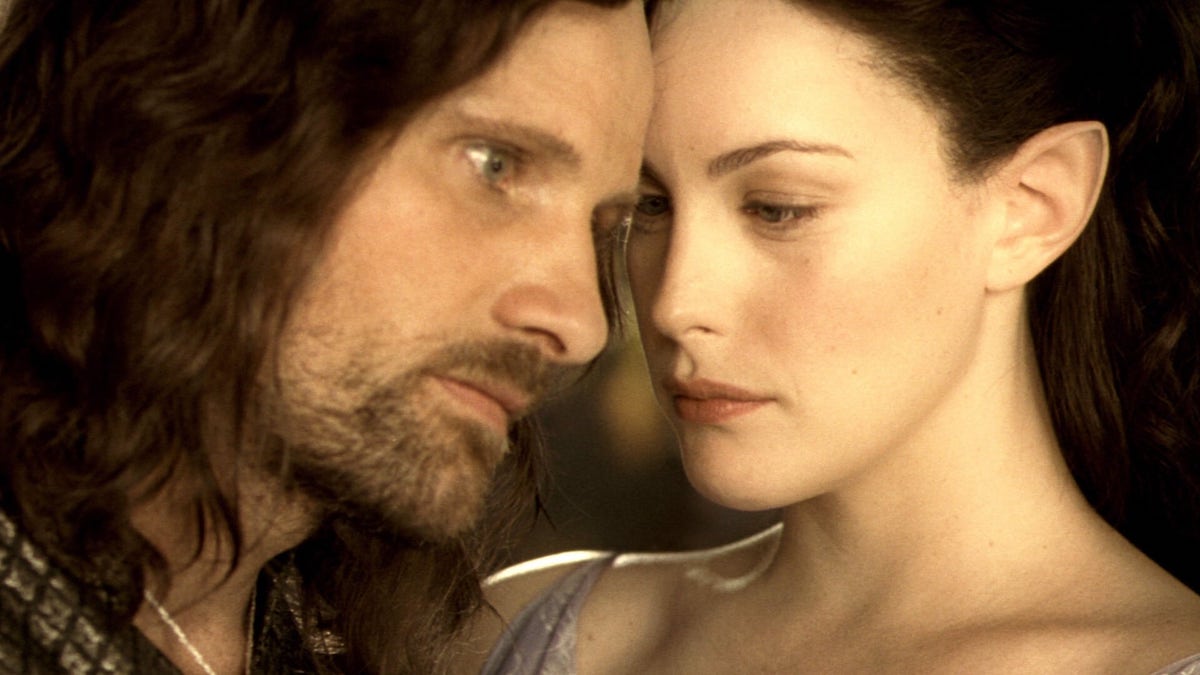
With Bloom and Rhys-Davies, their chemistry as budding friends becomes only more palpable and Legolas and Gimli grow closer as partners in battle—a far cry from their initial animosity towards the beginning of Fellowship—trading insults and quips while showing off their individual skills in combat, and even tallying their kill counts as competition in major battles. Hill, meanwhile, brings honour, dignity, grief, and desperation to the character of King Théoden, a staunch, bereaved, and noble ruler who would undoubtedly give his life for his people in a pinch, but grows to face the bleak idea of his people losing their lives alongside him as the scope of the enemy’s reach becomes clear. As for McKellen, Gandalf’s spiritual upgrade from the Grey to the White offers the character virtually unrivalled wisdom and even further ennobled strength of will, expanding further on his already brilliantly sage turn in Fellowship by adding onto it a sense of greater resolve and knowledge on how best to fend off the enemy’s encroaching path of malice.
Frodo and Sam are the two characters whose immediate surroundings could not possibly be further from the homely peace of the Shire—surrounded all around by death, corruption, and temptation, their characters undergo heavy disillusionment as the film progresses, even as they try to hold onto the humanity they have left. Sean Astin still maintains Sam’s charm as the emotional heart of the trilogy, showing a fiercely protective side when it comes to ensuring Frodo’s safety against all possible threats that affirm his loyalty and the depth of his friendship beyond merely naïveté. Elijah Wood, meanwhile, imbues in Frodo a never-before-seen vulnerability especially as the Ring’s hold on Frodo only grows stronger, one that subtly yet surely makes him all the more desperate to try and enter Mordor, and also plays into his decision to keep Gollum around as a guide, even as it becomes increasingly apparent how dangerous he is in the presence of the Ring.
It’s here that Andy Serkis needs to be mentioned as the film’s most obvious acting highlight, as he expresses every minutia of Gollum’s physical frailty, shattered psyche, and hoarsely sly tone of voice with nothing short of completely immersive dedication to the role. As much as Gollum’s outward appearance may be the product of fantastically detailed motion capture and computer-generated effects, no one can deny that Gollum’s instantly iconic, raspy voice, as well as his weakened yet sly physicality, are themselves all products of Serkis’s complete mastery of the character, making the audience completely aware of not just how tragic the fate of a Ringbearer is in the long run, but also how dangerous the Ring’s corruption can truly make someone, in much the same way as addiction can act when it persists for far too long. Gollum is unbelievably deceptive, feigning kindness with morbid humour one moment and shifting into rage the moment an opportunity to regain the Ring slips out of his grasp, and Serkis ensures that none of these details about Gollum’s character is accidental. It’s a legendary, iconic performance that set an incredible standard for motion-capture acting in multiple audiovisual mediums, and skyrocketed Serkis’s prolific career to untold heights.
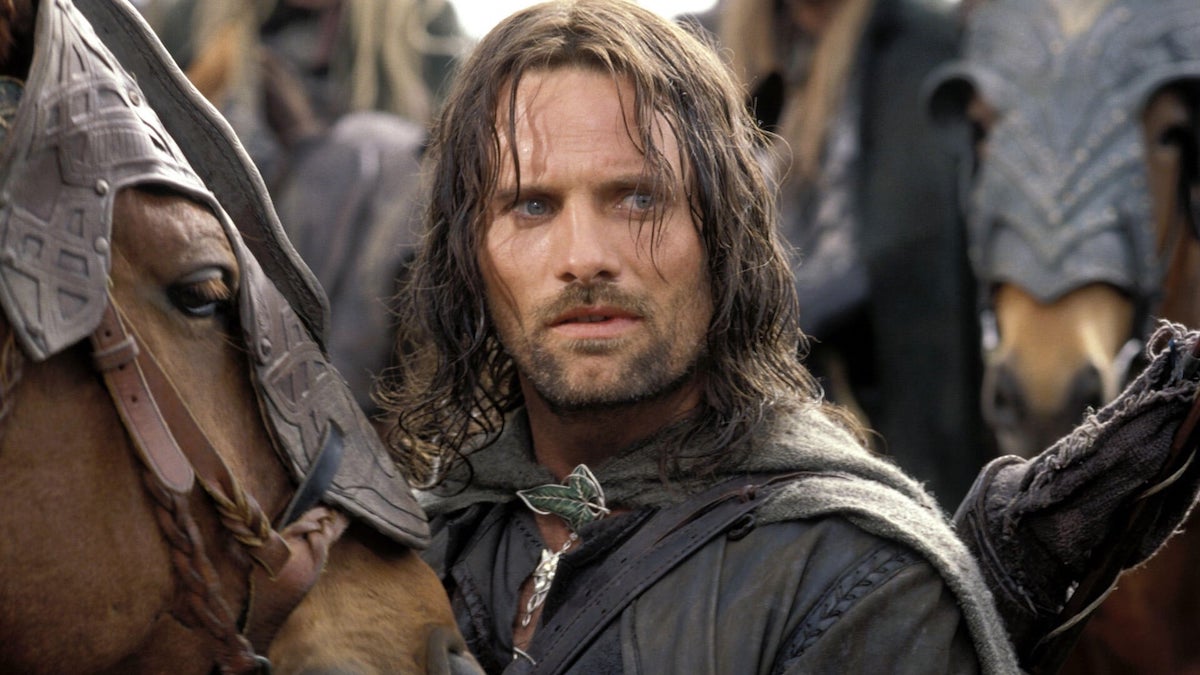
With all this growth and development also comes the expansion of the trilogy’s utterly grandiose spectacle, and the film’s centrepiece, the 40-minute-long Battle of Helm’s Deep, is a reaffirmation of the trilogy’s unbelievable technical skill in creating a sense of peril and awe in large-scale warfare, as well as a testament to the narrative prowess of Jackson and co-writers Fran Walsh and Philippa Boyens. Filmed almost entirely in the nighttime with striking usage of contrast in a rainy dark-blue haze and radiant backlights by cinematographer Andrew Lesnie, the entire battle is an expertly framed series of escalations in stakes, triumph, despair, and ultimately a grand sense of hard-won victory—in essence, a microcosm for the grand journey of the trilogy itself, framed through an absolutely colossal battle that showcases the characters’ prowess and determination as well as a breathtaking sense of scale. Nearly every last one of the 10,000 Uruk-hai clashing against the hundreds of Rohirrim and Elvish soldiers sent by Lady Galadriel (Cate Blanchett) and Lord Elrond (Hugo Weaving) are framed in their entirety with expansive wide shots that capture the lengthy spears and equipment of the former against the fearful, scantily armed close-hand combat of the latter, all while we get to see Aragorn, Théoden, Legolas, and Gimli fight their way through the varying obstacles that the Uruk-hai throw at them with inspiring fierceness. The end result is a climactic battle for the ages that’s not only overpoweringly fantastic but easy to follow and emotionally engrossing, shot over the course of four months with such incredible attention to detail and scope that it’s no wonder that Helm’s Deep has become as much of a legendary moment in fantasy cinema as it’s become.
One of the most important things to know about The Lord of the Rings is that many of its depictions of war are based on Tolkien’s own experience fighting in World War I under the British Army—he had contracted trench fever, nearly lost his entire battalion, and grieved the senseless death of many close friends by the time his service ended. It’s the reason why Tolkien’s vision of war still persists in such a visceral way in his novel, even despite being expressed through the lens of high fantasy, and it’s something that Jackson and the team behind Rings seem to have taken deeply to heart in the process of making The Two Towers. There are moments of relentless darkness in this film, many of which have already been mentioned above, and all of which contribute to an unflinching, oppressive portrayal of the horrors that war and its instigators bring. One of the trilogy’s greatest strengths is that it makes evil tangible, not just through its all-consuming fire-and-brimstone aesthetic, but also through how the trilogy expresses in harrowing ways its constant hunger for more—its desire to reshape the world in its own image is so bleak it becomes unbearable to even imagine.
But by the time The Two Towers ends, it becomes abundantly clear that even as the Rohirrim, Gondor, the Ents, and the Fellowship may have differing, even diametrically opposed interests along the journey, they are all ultimately unified under the common desire to defeat this evil once and for all, and that even the slightest effort dedicated towards that unique solidarity towards stopping the spread of evil makes a world of a difference. It’s an incredibly hopeful arc at the end of unrelenting darkness that allows the film to stand alone on its own merits, and also mark the beginning of the end of this grand saga. Frodo and Sam are getting even closer to Mordor. Rohan has fended off the enemy. Isengard has been weakened. But the One Ring will only grow stronger as the film approaches its destination, and Sauron’s forces will grow in strength alongside it. It’s one thing to capture lightning in a bottle, and another to keep it contained, but the most challenging task of all is to pay it all off, and the last of The Two Towers‘ many great achievements is how it perfectly sets the stage for the trilogy’s grand finale.
NEW ZEALAND • USA | 2002 | 179 MINUTES (THEATRICAL) • 235 MINUTES (EXTENDED EDITION) | 2.39:1 | COLOUR | ENGLISH • SINDARIN

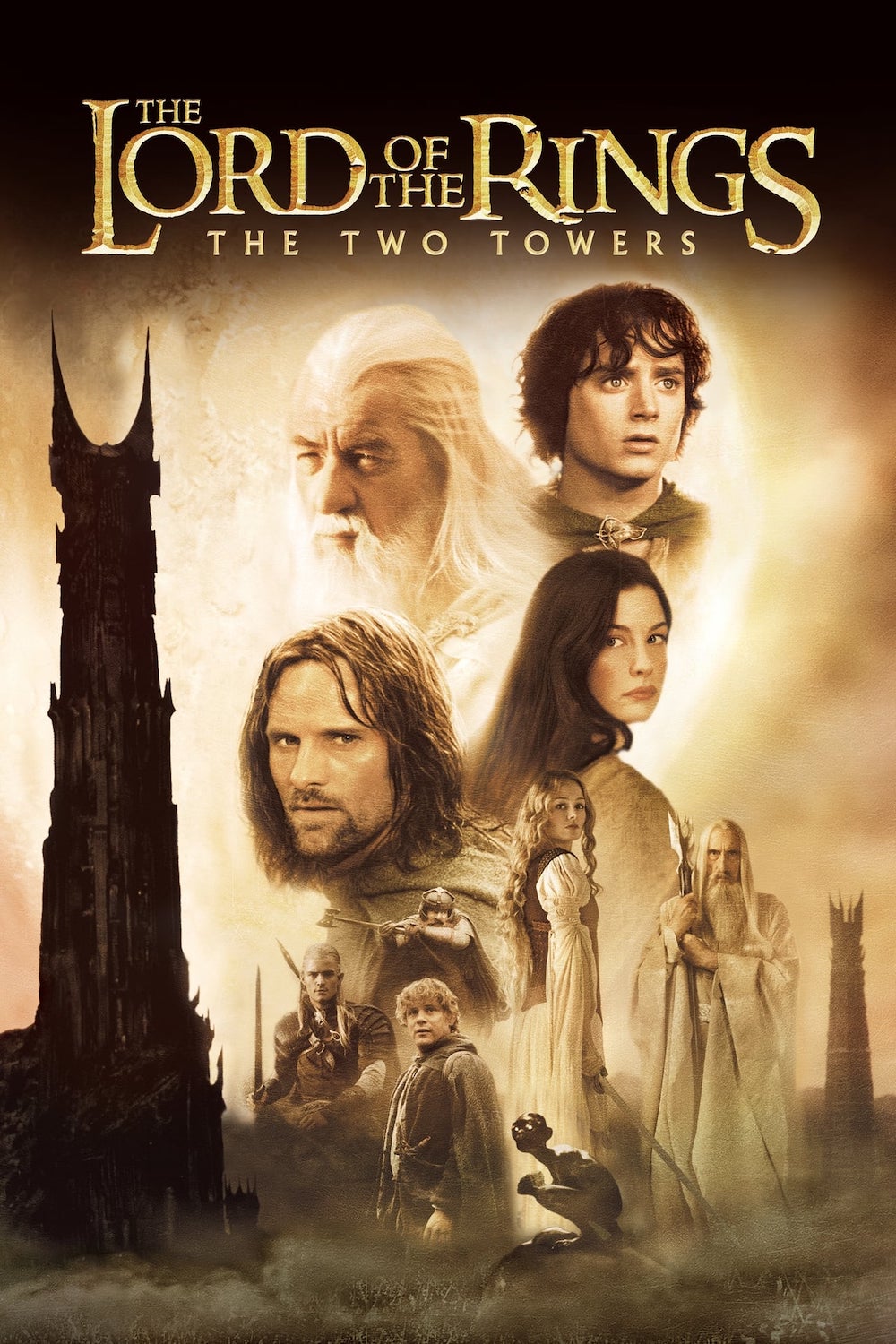
director: Peter Jackson.
writers: Fran Walsh, Philippa Boyens & Peter Jackson (based on the novel by J.R.R Tolkien).
starring: Elijah Wood, Ian McKellen, Liv Tyler, Viggo Mortensen, Sean Astin, Cate Blanchett, John Rhys-Davies, Billy Boyd, Dominic Monaghan, Orlando Bloom, Christopher Lee, Hugo Weaving, Bernard Hill, Karl Urban, David Wenham & Andy Serkis.
